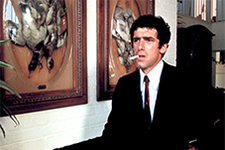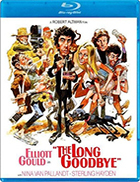The Long Goodbye
|  Robert Altman’s The Long Goodbye opens with its protagonist, private detective Philip Marlowe (Elliot Gould), being awoken in the middle of the night by his cat, who is hungry and wants a particular brand of cat food that Marlowe does not have. Marlowe, rumpled and disoriented, ends up making a run to an all-night grocery store, which also lacks the cat’s favorite brand of chow, after which he tries—and fails—to trick the cat into thinking it is eating its preferred brand by swapping labels. This is a far cry from the manner in which Marlowe—the epitome of the hard-boiled detective—has been introduced in other films: Murder, My Sweet (1944), where he was played by Dick Powell; The Big Sleep (1946), where he was played by Humphrey Bogart; and Farewell My Lovely (1975), where he was played by Robert Mitchum. No—Gould’s Marlowe is a different character altogether, which is why long-time fans of Raymond Chandler’s literary creation were not exactly pleased with the film. Of course, pleasing people has never really been director Robert Altman’s strong suit, particularly in the early 1970s, when his primary artistic agenda was to upend conventions, deconstruct genres, and generally go against the grain in every way possible. The Long Goodbye is an important film in this regard, as it was one of the first to ransack and rework the cherished traditions of that most fabled of post-war American genres, film noir, not as a direct parody, but as a sly satire of masculinity, official power, and the bizarre world of post-’60s Los Angeles. It is not without purpose that Marlowe is first seen waking up in the film, as Altman thought of him as “Rip Van Marlowe,” a character out of time who still holds fast to conceits and convictions of an earlier era that get him nowhere in the modern age. The narrative kicks off (well, after the cat episode, anyway) with the arrival of Terry Lennox (Jim Bouton), an old friend of Marlowe’s who has been fighting with his wife and wants a ride to the Mexican border. Marlowe dutifully follows through on the favor, after which he learns that Terry’s wife has been killed and he is most likely her killer. He then gets thrown in jail for three days and relentlessly interrogated, finally being freed when news arrives that Terry has killed himself and confessed in a note. From there Marlowe gets involved with Eileen Wade (Nina van Pallandt), the long-suffering wife of the alcoholic, Hemingway-esque writer Roger Wade (Sterling Hayden), who has gone missing on one of his drinking binges. This draws Marlowe deeper down the rabbit hole, which is populated with the likes of Henry Gibson’s creepy pseudo-psychologist Dr. Verringer and Mark Rydell’s skeevy gangster Marty Augustine. Believe it or not, this all connects back to Terry Lennox, although the manner in which Marlowe uncovers clues and learns information has more to do with serendipity than any real detective skills. If the film holds together, it is largely because of Elliot Gould’s ramshackle performance, which turns Marlowe into a figure who is both absurd and strangely compelling. He gets no respect from anyone—not the cops, not Roger Wade, not the stoned hippie-girls who live next door and practice topless yoga, and certainly not Eileen’s Doberman, which attacks him every chance it gets—but he still keeps pushing through, his chain-smoking becoming a distinct manifestation of his tenacity. Humiliation lurks around every corner, but it never really seems to faze him, which is why the film’s climactic moment, in which he responds with violence in a way that is both shocking and understandable, works so well (it has no corollary in the source novel and was the primary thing that convinced Altman to direct the film). Gould’s loser detective stands in stark contrast to Roger Wade, a gruff amalgam of macho cliches that that veteran actor Sterling Hayden manages to turn into a character both venerable and sad. He is, like Marlowe, a relic. The screenplay, which adapted Chandler’s 1953 novel of the same name, was written by Leigh Brackett, a fascinating figure in both Hollywood and science fiction who helped pioneer the subgenre of the space opera in sci-fi pulp magazines in the 1940s. She wrote in other genres, as well, including mysteries, and she caught the attention of director Howard Hawks with her 1944 novel No Good From a Corpse (as the story goes, Hawks, after reading the novel, told his secretary to “call this guy Brackett”). She ended up writing or co-writing five films for Hawks, including The Big Sleep (the second film adaptation a Phillip Marlowe novel and easily the most iconic), Rio Bravo (1959), and Rio Lobo (1970). Her last screenwriting project was the sequel to Geoge Lucas’s Star Wars (1977), the first draft of which she finished just weeks before she died of cancer. The Long Goodbye was her penultimate script, and her willingness to deconstruct the very lore she had helped create with her screenplay for The Big Sleep (which she cowrote with William Faulkner) shows that she was wily and creative to the very end.
Copyright © 2021 James Kendrick Thoughts? E-mail James Kendrick All images copyright © Kino Lorber / MGM | |||||||||||||||||||||||||||||
Overall Rating: 

 (3)
(3)


